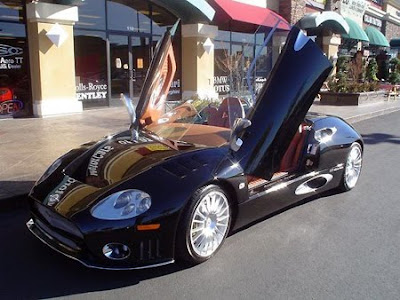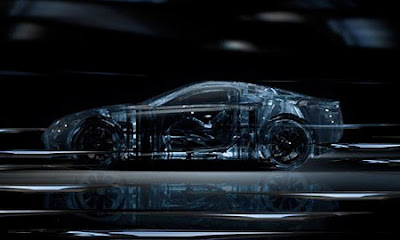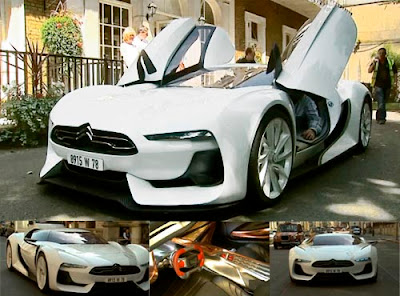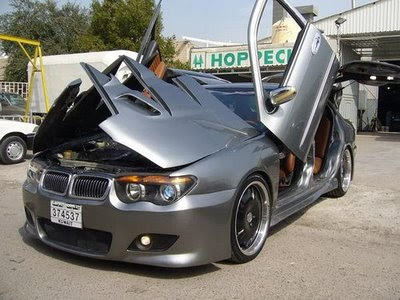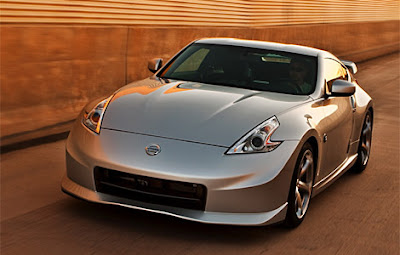

 The company that became Alfa Romeo was founded as Società Anonima Italiana Darracq (SAID) in 1906 by the French automobile firm of Alexandre Darracq, with some Italian investors. Late 1909, the Italian Darracq cars were selling slowly and a new company was founded named A.L.F.A. (Anonima Lombarda Fabbrica Automobili English: Lombard Automobile Factory, Public Company), initially still in partnership with Darracq. The first non-Darracq car produced by the company was the 1910 24 HP, designed by Giuseppe Merosi. A.L.F.A. ventured into motor racing, with drivers Franchini and Ronzoni competing in the 1911 Targa Florio with two 24 HP models. In August 1915 the company came under the direction of Neapolitan entrepreneur Nicola Romeo, who converted the factory to produce military hardware for the Italian and Allied war efforts. In 1920, the name of the company was changed to Alfa Romeo with the Torpedo 20-30 HP becoming the first car to be badged as such.
The company that became Alfa Romeo was founded as Società Anonima Italiana Darracq (SAID) in 1906 by the French automobile firm of Alexandre Darracq, with some Italian investors. Late 1909, the Italian Darracq cars were selling slowly and a new company was founded named A.L.F.A. (Anonima Lombarda Fabbrica Automobili English: Lombard Automobile Factory, Public Company), initially still in partnership with Darracq. The first non-Darracq car produced by the company was the 1910 24 HP, designed by Giuseppe Merosi. A.L.F.A. ventured into motor racing, with drivers Franchini and Ronzoni competing in the 1911 Targa Florio with two 24 HP models. In August 1915 the company came under the direction of Neapolitan entrepreneur Nicola Romeo, who converted the factory to produce military hardware for the Italian and Allied war efforts. In 1920, the name of the company was changed to Alfa Romeo with the Torpedo 20-30 HP becoming the first car to be badged as such.



In 1928 Nicola Romeo left, with Alfa going broke after defence contracts ended, and at the end of 1932 Alfa Romeo was rescued by Benito Mussolini's government, which then had effective control. The Alfa factory struggled to return to profitability after the Second World War, and turned to mass-producing small vehicles rather than hand-building luxury models. The company, in 1954, developed the classic Alfa Romeo Twin Cam engine, which would remain in production until 1995. During the 1960s and 1970s Alfa Romeo produced a number of sporty cars, though the Italian government parent company, Finmeccanica, struggled to make a profit so sold the marque to the Fiat Group in 1986.
Alfa Romeo has competed successfully in many different categories of motorsport, including Grand Prix motor racing, Formula One, sportscar racing, touring car racing and rallies. They have competed both as a constructor and an engine supplier, via works entries (usually under the name Alfa Corse or Autodelta) and private entries. The first racing car was made in 1913, three years after the foundation of the company, and Alfa Romeo won the inaugural world championship for Grand Prix cars in 1925. The company gained a good name in motorsport, which gave a sporty image to the whole marque. Enzo Ferrari founded the Scuderia Ferrari racing team in 1929 as an Alfa Romeo racing team, before becoming independent in 1939.
Foundation and Early Years
The company that became Alfa Romeo was founded as Società Anonima Italiana Darracq (SAID) in 1906 by the French automobile firm of Alexandre Darracq, with some Italian investors. One of them, Cavaliere Ugo Stella, an aristocrat from Milan, became chairman of the SAID in 1909.The firm's initial location was in Naples, but even before the construction of the planned factory had started, Darracq decided late in 1906 that Milan would be a more suitable location and accordingly a tract of land was acquired in the Milan suburb of Portello, where a new factory of 6,700 square metres (8,000 sq yd) was erected. Late 1909, the Italian Darracq cars were selling slowly and Stella, with the other Italian co-investors, founded a new company named A.L.F.A. (Anonima Lombarda Fabbrica Automobili), initially still in partnership with Darracq. The first non-Darracq car produced by the company was the 1910 24 HP, designed by Giuseppe Merosi, hired in 1909 for designing new cars more suitable to the Italian market. Merosi would go on to design a series of new A.L.F.A. cars, with more powerful engines (40-60 HP). A.L.F.A. ventured into motor racing, with drivers Franchini and Ronzoni competing in the 1911 Targa Florio with two 24 HP models. In 1914, an advanced Grand Prix car was designed and built, the GP1914 which featured a four cylinder, double overhead camshafts, four valves per cylinder and twin ignition. However, the onset of the First World War halted automobile production at A.L.F.A. for three years.
In August 1915 the company came under the direction of Neapolitan entrepreneur Nicola Romeo, who converted the factory to produce military hardware for the Italian and Allied war efforts. Munitions, aircraft engines and other components, compressors and generators based on the company's existing car engines were produced in a vastly enlarged factory during the war. When the war was over, Romeo invested his war profits in acquiring locomotive and railways carriage plants in Saronno (Costruzioni Meccaniche di Saronno), Rome (Officine Meccaniche di Roma) and Naples (Officine Ferroviarie Meridionali), which were added to his A.L.F.A. ownership.
Car production had not been considered at first, but resumed in 1919 since parts for the completion of 105 cars were still lying at the A.L.F.A. factory since 1915. In 1920, the name of the company was changed to Alfa Romeo with the Torpedo 20-30 HP becoming the first car to be badged as such. Their first success came in 1920 when Giuseppe Campari won at Mugello and continued with second place in the Targa Florio driven by Enzo Ferrari. Giuseppe Merosi continued as head designer, and the company continued to produce solid road cars as well as successful race cars (including the 40-60 HP and the RL Targa Florio).
In 1923 Vittorio Jano was lured away from Fiat, partly thanks to the persuasion of a young Alfa racing driver named Enzo Ferrari, to replace Merosi as chief designer at Alfa Romeo. The first Alfa Romeo under Jano was the P2 Grand Prix car, which won Alfa Romeo the inaugural world championship for Grand Prix cars in 1925. For Alfa road cars Jano developed a series of small-to-medium-displacement 4, 6, and 8 cylinder inline power plants based on the P2 unit that established the classic architecture of Alfa engines, with light alloy construction, hemispherical combustion chambers, centrally-located plugs, two rows of overhead valves per cylinder bank and dual overhead cams. Jano's designs proved to be both reliable and powerful.
Enzo Ferrari proved to be a better team manager than driver, and when the factory team was privatised, it then became Scuderia Ferrari. When Ferrari left Alfa Romeo, he went on to build his own cars. Tazio Nuvolari often drove for Alfa, winning many races prior to the Second World War.
In 1928 Nicola Romeo left, with Alfa going broke after defence contracts ended, and at the end of 1932 Alfa Romeo was rescued by the government, which then had effective control. Alfa became an instrument of Mussolini's Italy, a national emblem. During this period Alfa Romeo built bespoke vehicles for the wealthy, with the bodies normally built by Touring of Milan or Pinin Farina. This was the era that peaked with the legendary Alfa Romeo 2900B Type 35 racers.
The Alfa factory (converted during wartime to the production of Macchi C.202 Folgore engines) was bombed during the Second World War, and struggled to return to profitability after the war. The luxury vehicles were out. Smaller mass-produced vehicles began to be produced in Alfa's factories beginning with the 1954 model year, with the introduction of the Giulietta series of berline (saloons/sedans), coupes and open two-seaters. All three varieties shared what would become the classic Alfa Romeo overhead Twin Cam four cylinder engine, initially in 1300 cc form. This engine would eventually be enlarged to 2 litres (2000 cc) and would remain in production until 1995.
“ When I see an Alfa Romeo go by, I tip my hat. ”
—Henry Ford talking with Ugo Gobbato in 1939.
Post War
Once motorsports resumed after the Second World War, Alfa Romeo proved to be the car to beat in Grand Prix events. The introduction of the new formula (Formula One) for single-seat racing cars provided an ideal setting for Alfa Romeo's tipo 158 Alfetta, adapted from a pre-war voiturette, and Giuseppe Farina won the first Formula One World Championship in 1950 in the 158. Juan Manuel Fangio secured Alfa's second consecutive championship in 1951.
In 1952, Alfa-Romeo had experimented with its first front-wheel drive compact car named "Project 13-61". It had the same transverse-mounted, forward-motor layout as the modern front-wheel drive automobiles. Alfa-Romeo made a second attempt toward the late 1950s based on Project 13-61. It was to be called Tipo 103. It even resembled the smaller version of its popular Alfa-Romeo Giulia. However, due to the financial difficulties in post-war Italy, the Tipo 103 never saw the production. Had Alfa-Romeo succeed in producing Tipo 103, it would precede the Mini as the first "modern" front-wheel drive compact car.
During the 1960s, Alfa concentrated on competition using production-based cars, including the GTA (standing for Gran Turismo Allegerita), an aluminium-bodied version of the Bertone-designed coupe with a powerful twin-plug engine. Among other victories, the GTA won the inaugural Sports Car Club of America's Trans-Am championship in 1966. In the 1970s, Alfa concentrated on prototype sports car racing with the Tipo 33, with early victories in 1971. Eventually the Tipo 33TT12 gained the World Championship for Makes for Alfa Romeo in 1975 and the Tipo 33SC12 won the World Championship for Sports Cars in 1977.
By the 1970s Alfa was again in financial trouble. The Italian government company Finmeccanica bowed out in 1986 as Fiat Group bought in, creating a new group, Alfa Lancia Industriale S.p.A., to manufacture Alfas and Lancias. Models produced subsequent to the 1990s combined Alfa's traditional virtues of avant-garde styling and sporting panache with the economic benefits of product rationalisation, and include a "GTA" version of the 147 hatchback, the Giugiaro-designed Brera, and a high-performance exotic called the 8C Competizione (named after one of Alfa's most successful prewar sports and racing cars, the 8C of the 1930s).
In 2005 Maserati was bought back from Ferrari and brought under Fiat's full control. The Fiat Group plans to create a sports and luxury division from Maserati and Alfa Romeo. There is a planned strategic relationship between these two; engines, platforms and possibly dealers will be shared in some market areas.
In the beginning of 2007, Fiat Auto S.p.A. was reorganized and four new automobile companies were created; Fiat Automobiles S.p.A., Alfa Romeo Automobiles S.p.A., Lancia Automobiles S.p.A. and Fiat Light Commercial Vehicles S.p.A. These companies are fully owned by Fiat Group Automobiles S.p.A.
Carabinieri and Italian Government
In the 1960s Alfa Romeo became famous for its small cars and models specifically designed for the Italian police — "Panthers" and Carabinieri; among them the glorious "Giulia Super" or the 2600 Sprint GT, which acquired the expressive nickname of "Inseguimento" dir. trl. "to chase or predate" (this car is wrongly supposed to be the one that the famous Roman police marshal and unrivalled driver Armandino Spadafora brought down on the Spanish Steps in 1960 while following some robbers — it was actually a black Ferrari 250 GT/E — this picture of Giulia,[19] one of the dozens about this legend, is taken from a film and not at the Spanish Steps). The colours of the Alfa Romeos used by the Polizia were grey/blue with white stripes and writing, known as "Pantera" (Panther), enhancing the aggressive look of the Alfa (particularly the Giulia series), while the Carabinieri Alfas were dark blue with white roofs and red stripes, known as the "Gazzella" (Antelope) denoting the speed and agility of these "Pattuglie" (armed response patrol units). However, the term "Pantera" became used interchangeably and the image helped create a no-nonsense, determined and respected perception by the general public of the men that drove these cars, true to their history.
Since then, Alfas remain the chosen mount of the Carabinieri (renowned arm of the Italian Armed Forces seconded only partly for civilian Policing purposes), Polizia Autostradale (Highway Police) and the conventional police service (Polizia). Successively, the following Alfa Romeo Berlinas have found favour for Italian Police and Government employment:
- Alfa Romeo Alfetta
- Alfa Romeo "Nuova" Giulietta
- Alfa Romeo 75
- Alfa Romeo 164 (Official Vehicles)
- Alfa Romeo 155
- Alfa Romeo 156
- Alfa Romeo 166 (Official Vehicles)
- Alfa Romeo 159
Since 1960s, the Italian Prime Minister has used Alfa Romeos (and lately the new Maserati Quattroporte) as preferred government limousines. The 164, and 166 have found particular employment in the last two decades.
Recent Developments
Alfa Romeo has been suffering from falling sales. Some analysts concluded that the automaker suffered large operating losses in the mid-2000s - estimated to be about 15 percent to 20 percent of the Alfa’s annual revenues—or about 300 million to 500 million euros a year. For the year of 2010, it sold a total of about 112,000 units which was significantly lower than Fiat CEO Marchionne's global sales target of 300,000. Alfa wants to achieve 170,000 sales in 2011, including 100,000 Giulietta and 60,000 MiTo, and 500,000 by 2014 including 85,000 from N. American market.
Return to the United States
Alfa Romeo was imported to the United States by Max Hoffman starting from the mid 1950s. The Giulietta Spider was born by request of Max Hoffman, he made proposal to produce an open version of the Giulietta. In 1961 Alfa Romeo started importing cars to the United States.
In 1995 Alfa Romeo ceased exporting cars to the United States, the last model to be sold being the 164. Rumours began of their return, however as the FAQ on Alfa's English website had said "The long-awaited return of Alfa Romeo to the United States market should take place by 2007, with a range of new models."
Alfa Romeo's return to United States was confirmed on 5 May 2006 by Fiat CEO Sergio Marchionne. Alfa Romeo resumed sales in the United States with the 8C Competizione in October 2008. Alfa Romeo and Chrysler are currently in discussions, with Alfa Romeo possibly using Chrysler manufacturing plants that have been shut down due to unneeded product.
The Wall Street Journal reported on Nov. 4, 2009, that Chrysler would announce that it is dropping several models of Dodge and Jeep while phasing in Alfa Romeo and Fiat 500 models.
The Alfa Romeo 4C will be the first car to re-enter the US market in 2012 (if the 8C is not counted). Orders for the 4C will be taken in the fourth quarter of 2012, and deliveries will begin in early 2013.

























